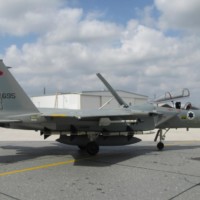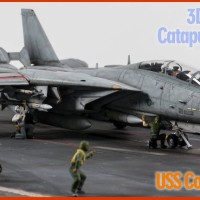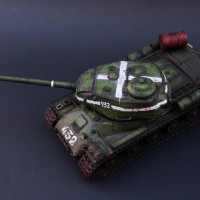A Vigorous Dragon
Subject
The Chengdu J-10 is the first successful indigenously designed Chinese fighter aircraft. Other Chinese fighters have been and are of Russian origin, although increasingly the latest versions have been heavily developed and modernised to include Chinese systems, sensors and weapons. But the J-10 is an original Chinese design and has been progressively developed into an extremely capable 4.5th generation multi-role combat aircraft. Christened “Vigorous Dragon” by the Chinese, the J-10 has been assigned the NATO reporting name “Firebird”.
Design work started in the 1980s but various delays, including problems developing the intended engine, meant that wasn't until 23 March 1998 that the first prototype flew, although powered by Russian AL-31FN turbofans.
Initial versions of the J-10 have a rectangular engine intake with a boundary control splitter plate, reminiscent of the Eurofighter Typhoon, and a squared -off vertical fin. In 2008 the J-10B was unveiled featuring a new Diverterless Supersonic Inlet (DSI), a taller, rounded fin, an Infra-Red Search and Track (IRST) sensor in front-right of the cockpit and a Passive Electronically Scanned Array (PESA) radar under a reshaped radome. This was a significant upgrade in combat capability.
In 2016, the J-10C arrived, now with the definitive and much more capable Active Electronically Scanned Array (AESA) radar and armed with the latest long-range PL-15 and short-range PL-10 missiles. From 2019, the J-10C has been powered by the now mature Chinese WS-10 turbofan.
The J-10C can be distinguished from the J-10B by the three blade antennas on the spine of the fuselage.
The kit provided schemes are almost identical and are painted in two greys, upper and lower. One of the options has high-viz national insignia and a yellow serial number on the fin while the other two have low-viz insignia and light grey serial numbers on the fin. The scheme I chose also has an eagle head painted just ahead of the canards. Photos of this scheme can be found on the internet.
Construction
This is a well-designed kit with very few issues, so construction was straight forward. The only real issues were that the instructions included some parts that are appropriate for the J-10A or B but not the C. However, a careful examination of photos shows which of the various intakes and antennas should be used.
An example is the three blade Soviet type IFF antenna under the rear fuselage. Photos show that the J-10C has a single, swept blade antenna instead. I fabricated one out of a piece of fin from an unused drop tank. I later found an unused swept blade antenna on the sprues, but this looked to be too long anyway.
There is a GPS dome on the spine behind the cockpit and behind that is a flat rectangular antenna. The kit has the latter as a very narrow rectangle whereas photos show it to be more of a square. So, once I had assembled the fuselage halves, I cut the antenna off and replaced it with a square of plastic card with rounded corners. I then built up the area under this with putty to blend it into the fuselage.
The kit cockpit is nicely detailed with decals for the finer detail on the instrument panel and side consoles. The seat is also well done and the kit includes a photo-etch harness, which is adequate, but rather simplified. So, I decided to purchase a Mini Craft Collection 3-D printed HTY-5 ejection seat for both finer seat detail and the more realistic moulded-on harness.
Otherwise, the kit is a pretty straight forward build and the fit of parts is generally very good. However, I wish that the three pitot tubes weren't butt joined to the fuselage and had attachment peg-and-holes instead. I managed to knock each of them at least once each and lost one in the process. Fortunately, there are two spares on the sprue.
Colours and Markings
Trumpeter suggests Gunze H61 IJN Grey for the upper colour, which is not a bluish grey, and Gunze H308 with H11 White (4:1) for the underside. Both H61 and H308 are very similar greys. However, in photos of J-10s on the internet the colours look to be a bluish grey over a light grey.
As it happened, I purchased a bottle of H308 which was not the same grey as the previous one that I used on my J-20. The new bottle was a little bluish. So, I decided to reverse the recommended paints and used the H308 for the Bluish Grey and mixed H61 and H11 (9:2) for the lower Pale Grey colour.
The instructions indicate that the radome should be painted H307 FS36320, but photos indicate that it should be a near-black grey, so I used Tamiya XF63 German Grey. The blade antennas were painted H59 IJN Green as per the instructions, as this agreed with photos, and other antennae were painted H53 Neutral Grey.
The decals are extremely thin and care must be taken in order to not to stretch them or have them fold over on themselves. I decided to only apply the aircraft markings and significant functinal stencils and avoided applying the numerous small common character strings that were indicated on various access panels.
Conclusion.
There are one or two errors in the instructions, but careful reference to photos - something I always try to do - sorted these out.
This is an overall great kit and a fun build of an important modern combat aircraft.
















Typical very nice Michael Turner project, great work and a superb result.
Excellent result, Michael!
A wonderful result it is, Michael @michaelt
Very nicely presented as well.
Well Done Michael (@michaelt). Perhaps someday, we can have more consistency between paint manufacturers, model manufacturers, and color standards with regards to paint colors. Until then, it is prudent that we always test the colors before using them, even when using the same paint as previous (as you pointed out with MrColor).
G’day Carl (@clipper),
Thanks for looking and your kind comments.
The colour difference could have been my fault - lack of mixing before spraying, perhaps. However, we do tend to assume that one bottle will be exactly the same colour as the last.
When it came to my underside mix, I found that I had just enough to finish painting the drop tanks, so that worked out well.
Very nice! Don't see many Chinese subjects built, so refreshing to see something different.
Very nice J-10C Michael, beautifully built and painted. I have one of these in my stash. Your write-up on matching Gunze colours was very useful. Did you do pre-shading or post shading for weathering? It seems like you got some nice tonal variation and panel line accent in the greys you used. Maybe that came from careful airbrushing, but it is nice just the same. The J-10 is a handsome aircraft and it is nice to see a detailed quality build to inspire the rest of us.
G’day Colin (@coling),
Thanks for looking and your kind comments.
I used to preshade my kits, but occasionally ended up with an underlyind texture difference (slightly thick paint or shiny vs matt surface) that showed through the top coat.
When I recently built my Avenger and painted it with SMS paints, I first painted a black SMS undercoat - the first time I think I’ve done that.
It occured to me then that, rather than preshade (black on black?), I could just “colour in” the panels for the same effect.
I essentially do this by applying a very tight scribble until I’m satisfied with the coverage and effect.
That means the panel lines have a lighter coverage than the panel center, mimicking pre/post shading.
As the J-10C is a fairly new aircraft and available photos show them to be clean, I didn’t apply any more weathering to it. I had considered a light panel wash (something I have just started trying on my modern jet builds) but decided it might ruin the effect.
I look forward to seeing your’s built, too.
Nice work indeed Michael. A very nice addition for your collection.
The Chinese have done a lot of design in blending several fighters into the J-10 😝
I see Eurofighter as you said, F-16, Griffen, even some Mig-29 and Su-27.
IIRC, a US Congressional investigation came to the conclusion that the J-10 is the result of Israel selling the plans for their Lavi fighter to China. This was a very big deal back in the 1990's and was a major political obstacle Israel had to overcome in its bid to join the F-35 consortium.
The J-10 was no doubt heavily influenced by the Lavi, but I understand that it is quite a bit larger and certainly has evolved significantly in technology and performance since.
G’dy Tom (@tcinla), Spiros (@fiveten), John (@johnb), Greg (@gkittinger)and Scott (@scottiya),
Thanks all for looking and commenting.